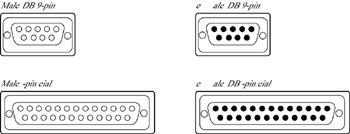SERIAL PORTS AND CONNECTORS
Today’s computers typically come equipped with one or two RS232C-compliant serial ports that are also located on the back of a computer system. (Refer to Figure 21.1 for a standard serial port.) A serial port transmits data one bit at a time. To transmit a byte (eight bits) serially, eight separate bits are transmitted one at a time, one after another. For example, try to picture pouring eight marbles into a funnel all at the same time. Only one of the marbles can exit the funnel at a time. All the other marbles will follow the first marble until the funnel is empty. Serial transmission is much slower than any of the parallel transmission techniques.
An operating system identifies serial ports in the BIOS setup program and references the serial ports as COM ports. The first serial port is referenced as COM1, the second serial port is referenced as COM2, and so on for COM3 and COM4.
Serial ports can come in the form of a DB 9-pin or older style DB 25-pin male connector. Most systems today have one DB 9-pin (male) serial port that is used for a serial mouse or a communications device, such as a modem.
Two basic serial cables are available that are used to connect a device to a serial port. The most common serial cable in use today has a DB 9-pin female adapter on one end of the cable that plugs into the DB 9-pin male serial port on the system unit. The other end of the cable has a DB 25-pin male connector, which is connected to a DB 25-pin female connector on the external device. An older-style serial cable is the DB 25-pin female to DB 25-pin male, which can connect two devices that have DB 25-pin serial ports. Yes, serial cables can network two computers together, but you should expect very slow transmission rates. Regardless of which serial cable is in use, the maximum length of a serial cable should not exceed 25 feet. Figure 21.3 displays the pin array configurations for male and female DB 9-pin and DB 25-pin serial connectors.

Figure 21.3: Male and female DB 9-pin and DB 25-pin serial connectors.
EAN: 2147483647
Pages: 390